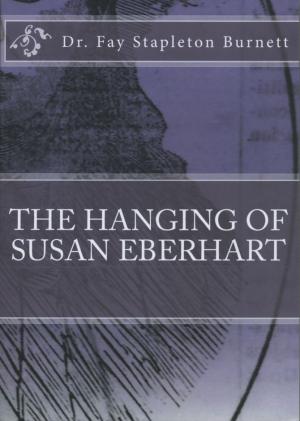“The grave opens to receive me and I am ready to sink into its depths.”—19-year-old Susan Eberhart, May 2, 1873, one hour before her execution
In the second half of the 19th Century, hundreds of murders occurred in Georgia, but only two murder cases electrified the entire state. Both cases were the subject of massive amounts of publicity in Georgia newspapers, and for years both cases were ceaselessly talked about in every part of this state.
One of these two notable murder cases was the Woolfolk murder case, involving Tom Woolfolk, nicknamed Bloody Woolfolk, who in 1887 murdered nine members of his family with an axe in Bibb County and after two trials was hanged in 1890. In 1997, I published a book review in Flagpole of Carolyn DeLoach’s The Woolfolk Tragedy (1996), a book that was the definitive account of that grisly murder case until the publication of Ms. DeLoach’s follow-up book, Shadow Chasers: The Woolfolk Tragedy Revisited (2000).
The other late 19th Century Georgia murder case to transfix the people of this state was that of Susan Eberhart, hanged in 1873.

Dr. Fay Stapleton Burnett, a native Georgian from Winder, has authored a minutely researched, captivating book that is the definitive account of the Susan Eberhart murder case. The Hanging of Susan Eberhart (Amazon CreateSpace, August 2018) deserves reading by all who wish to know the facts about what this state’s newspapers once called “one of the strangest cases in the annals of crime,” and “the most interesting case of crime that ever occurred in Georgia.” The book also merits reading by Georgians who seek insights into the nature of society and the status of law, justice and religion in Georgia in the half-century following the end of the Civil War.
Dr. Fay Stapleton Burnett is not an academic historian, and her work is narrative history, not a scholarly piece of analytic history. This is an advantage for her readers. She knows how to tell a story well, and a great strength of her landmark book is that it quotes extensively from contemporary newspaper accounts, allowing her readers to view the Susan Eberhart case from the perspective of the Georgians of the time.
The Basics of the Susan Eberhart Case
Here is a short summary of the facts of the Susan Eberhart case, as set forth in Dr. Fay Stapleton Burnett’s book:
Susan Eberhart was born to a poor family in Stewart County on Sept. 9, 1853, and grew up in extreme poverty. She attended school for only three months, when she was six years old. She could barely read and write. In December 1871, Susan’s parents arranged for their 18-year old daughter to begin working in Webster County (originally named Kinchafoonee County) in the household of an unhappily married couple, 36-year Enoch Ferdinand Spann and his one-legged, invalid 50-year old wife, Sarah.
Dirt-poor, frequently quarreling hotly, Enoch Spann and the sour-tempered Sarah Spann lived in a small, one-room log cabin. Susan arrived there barefoot but soon was given a pair of shoes by Enoch Spann. Susan’s duties: to wash, cook, perform household chores and help take care of Sarah.
Susan Eberhart is a tall, slim girl with long dark hair and dark eyes. There is a consensus among those who know Susan: all her life she has been “obedient, dutiful, kindly disposed, quiet, and modest in her deportment.” She is not unintelligent but knows nothing of the world.
Unknown to Susan Eberhart or her parents at that time, but apparently known to just about everyone else who ever encountered him, Enoch Spann is densely stupid and crazy as a loon. Born around 1835, both his parents died when he was an infant. He never learned to read or write. As a child, he ate dirt, had no friends except imaginary ones, and played with a toy gallows he constructed himself and on which he would pretend to hang make-believe criminals. When he served in the Confederate Army, his fellow soldiers considered him to be, in their own words, “very ignorant and very imbecile” and “to a certain extent, crazy or of unsound mind.” In 1851, at the age of 16, Enoch Spann, in exchange for five dollars, was induced to marry 30-year old Sarah Perkins, who was already pregnant by one of his acquaintances. In short, Enoch Spann, according to one newspaper account, was “universally regarded as possessing a very low order of mind—having not more than half sense,” and “was known to have [had] several spells of actual craziness or insanity for which he had been treated by a physician…”
This was the warped creature—the “crack-brained monster,” in the words of the press—into whose hands her own mother and father unknowingly delivered the young, naïve, uneducated Susan Eberhart. Within days, Enoch Spann began making sexual advances toward Susan and engaging in wild talk with her about how he was going to kill his wife and marry Susan. She repeatedly begged him to stop saying such things and asked him if he had gone crazy. “[N]ever speak to me again,” she told him, “if that is the way you to have to talk.”
Soon, however, after two farcical failed endeavors to kill Sarah Spann—first by drowning her in a creek on the way to Sunday church and then by holding her head down in a water-filled barrel—Enoch Spann finally murdered his wife late on the evening of May 4, 1872, when he strangled her in her bed with a plow line, breaking her neck in the process. Susan did not participate in the murder except that, threatened by Spann, and in fear of her life, she did comply with his order to hold a handkerchief over the victim’s mouth so her screams would not be heard. After Sarah Spann was dead, Susan, over-awed and menaced by Spann, unwisely agreed to his demand that she flee the state with him. They set out on foot around 3 a.m., on May 5, five hours after the murder.
Nine days later, after pursuing the two fugitives for 125 miles, a Webster County posse on horseback caught up with the couple and captured them in Coffee County, Alabama. Brought back to Georgia, Eberhart and Spann were indicted swiftly for murder and speedily tried separately. Each trial lasted one day and resulted in a verdict of guilty and a sentence of death. At the trials, neither defendant called any witnesses or introduced any evidence.
Tried first, Enoch Spann, unlike Susan Eberhart, did not contest the charges. At Eberhart’s trial, the evidence against her consisted almost entirely of testimony by members of the posse, who claimed she made incriminating statements at the time of her arrest and on the trip back to Georgia. The testimony was certainly false.
On May 30, 1872, only 26 days after the murder, the trial judge sentenced Spann and Eberhart to be publicly hanged. After unsuccessful appeals to the Georgia Supreme Court, Spann died on the Webster County gallows (locally nicknamed “Bugger Bottom”) on Apr. 11, 1873, and Eberhart the following May 2.
The Final Days of Susan Eberhart
Once the Georgia Supreme Court upheld her sentence, Susan Eberhart knew she had only weeks to live unless Gov. James M. Smith used his broad executive clemency powers to commute her sentence to life imprisonment. Smith, a former blacksmith, was this state’s governor from 1872 to 1877.
Overwhelmingly, Georgians favored clemency for Susan Eberhart. Numerous clemency petitions were signed all over the state. The grand jurors who indicted her and the trial jurors who convicted her supported clemency. Newspapers across the state editorialized for clemency. Writing in his Atlanta newspaper, former Confederate Vice President Alexander H. Stephens joined the chorus favoring mercy. Deluges of letters asking Smith to commute Susan’s sentence and mentioning the mitigating circumstances in her case flooded the governor’s office.
Unfortunately for Susan Eberhart, the governor, as Dr. Fay Stapleton Burnett notes, “took an iron-fisted approach to anyone requesting a pardon or commutation.” Frighteningly compassionless, incapable of comprehending what mercy is, the governor unsurprisingly refused to pay serious attention to the many earnest pleas for mercy for Eberhart. His reptilian coldness, his stern unbending refusal to exercise the governor’s traditional fail-safe powers of clemency, not just in Eberhart’s case but also across the board, indicates that something was wrong with the man.
Gov. Smith waited as long as possible before announcing his predictable decision. On Apr. 28, 1873, four days before Eberhart’s scheduled execution, the governor released a letter officially refusing commutation. The tone of the letter shows that the unfeeling governor was under the delusion that commutations of sentence are only for the innocent. The letter claimed that he “had examined with great care” the clemency requests, but then proceeded to falsely (and irrelevantly) claim that “[t]he evidence shows beyond all question that [Eberhart] was sensible of the moral and legal guilt of the crime of murder.”
On the very morning Susan Eberhart was hanged, Gov. Smith had an interview with a newspaper reporter in which he said things so outrageous that, in the scathing words of Dr. Fay Stapleton Burnett, “one might think that the Governor must have been drinking.” Gov. Smith told the reporter that he had “very carefully investigated” the Eberhart case and found “not a single item that points to commutation of the sentence.”
“I failed to find a single point on which to predicate a pardon or commutation,” he added.
The governor even claimed to have learned from “a reliable authority” that Susan Eberhart “was a vigorous, lusty, intelligent young woman;” that “[b]y her beauty and her passion, she completely bewildered [Enoch Spann] and held him in absolute control;” that “Spann was completely under her control, and a perfect slave to her passions;” and that Susan “was the willing incentive to the crime.”
In her book, Dr. Fay Stapleton Burnett wonders who the “reliable authority” was. She did not discover the answer, she informs me, until after her publication of her book, when she came across a June 20, 1906, Columbus newspaper article, “Gov. Smith and the Susan Eberhart Case.” Subtitled “A Case That Stirred the State,” the article discloses that it had been James M. Clark, the superior court judge who presided at Susan’s murder trial, who secretly (and falsely) told Gov. Smith that Susan Eberhart was some sort of domineering, depraved, concupiscent seductress and murderess who held Enoch Spann in her thrall. If the judge did tell the governor this preposterous and untrue tale, we can be confident that the judge at Susan Eberhart’s trial was not impartial.
Gov. Smith’s decision to disregard the will of the people and allow Susan Eberhart’s hanging ruined his political career—“dug his political grave,” as the press phrased it. Throughout the state, there was hostility to the governor’s inaction. With few exceptions, Georgia newspapers denounced him vituperatively, accusing him of embarrassing the state and “exhibit[ing] a cold and heartless nature.” Public criticism of Gov. Smith continued for the rest of his life, and the people of this state never again elected him to any office. His political career, it was said, ended with the drop of the trapdoor under Susan Eberhart’s feet. After Smith’s death in 1890, his grave remained unmarked for 35 years.
Terrified of the certain death now awaiting her, Susan Eberhart, now 19 years old, spent her last days sitting on a wooden box in a bare jail cell weeping. However, on her last day on earth, Susan Eberhart—“this most unfortunate, friendless girl,” this “poor peasant girl,” this “seduced country girl,” as sympathetic newspapers described her— courageously accepted her fate. When on the morning of her hanging the officers who were to escort her to the place of execution entered her cell, she coolly asked, “I suppose my time has come?” When they said it had, she calmly replied, “Well, I am ready.” Susan Eberhart ascended the gallows bravely, without tears, displaying no fear.
The Botched Public Hanging of Susan Eberhart
Susan Eberhart’s execution was unlike most public hangings, because the crowd sympathized with the condemned person. The spectators watched what was happening in unusual, motionless silence—until the platform on which Susan was standing suddenly dropped with a bang, she fell five feet, and the execution scene abruptly turned nightmarish.
An inexperienced hangman, the Webster County sheriff had not properly secured the noose around Susan’s neck. The result was a terribly botched execution. With the crowd watching in horror, the young woman slowly choked to death, in convulsions and excruciating pain.
Dr. Fay Stapleton Burnett quotes some of the newspaper descriptions of Susan Eberhart’s dreadful death:
“Her neck was not broken. She struggled convulsively, drew up her body and arms and swung completely around, making fearful efforts to free her arms. Her hands opened and closed repeatedly. Every nerve in her body seem convulsed in agony, and her limbs opened and closed as if in wild and unavailing efforts to seek some foothold on which to rest her feet. There was, however, no rest for her… Every minute of torture seemed an hour to the crowd… A perceptible shudder passed through the spectators, who were all greatly affected. It was altogether a frightful scene… The stertorous breathing of the dying creature could be plainly heard at a distance of fifty feet, and after the expiration of fifteen minutes life was still apparent… She gradually ceased to struggle, and after nineteen minutes, her pulse and heart ceased beating… The crowd quickly left the tragic scene, many remarking that they hoped never again to witness such a terrible exhibition.”
Dr. Fay Stapleton Burnett does not mention it, but in 1893, twenty years after Susan Eberhart’s hanging, the General Assembly abolished public executions. The abolition may well have been attributable in part to Eberhart’s gruesome death. Certainly, in the immediate aftermath of her execution, and sometimes specifically mentioning Eberhart, numerous Georgia newspapers called for an end to “the hideous spectacle” of “the barbarism of public executions,” which were “repugnant to humanity.” The day after her hanging, one Atlanta newspaper editorialized: “Public executions are revolting to all the higher, tenderer, and civilizing influences of the mind… It is a duty we owe to religion and to civilization to put an end to this barbarism.”
Why Susan Eberhart Did Not Receive a Life Sentence
At Susan Eberhart’s trial, the jury, before returning its verdict, asked the judge if it could be merciful and recommend a sentence less than death. The jurors recognized that under the circumstances of the case, even if Susan was technically guilty of murder, she did not deserve hanging. The judge, however, prohibited the jury from recommending mercy. Their verdict, he instructed the jurors, had to be either guilty (which the jury knew meant an automatic death sentence) or not guilty (which meant Susan would walk free, without criminal punishment). The jury reluctantly found Susan guilty.
Dr. Fay Stapleton Burnett is at a loss to explain why the judge prohibited the jury from making a recommendation of mercy for (as she admirably phrases it) “the poor backwoods girl.” Her difficulty is quite understandable, since the correct explanation is legally complicated.
Here, as briefly put as possible, is why Susan Eberhart’s trial jury was unable to save her from a death sentence.
During the 19th Century, due to increasing uneasiness about the death penalty, the various states, one by one, began enacting laws abolishing the common law rule that death was the only possible punishment for the crime of murder. Under the reform legislation, the death penalty became discretionary rather than mandatory in certain murder cases. Under these statutes, persons convicted of murder now could be sentenced to life imprisonment instead of death. Georgia made this change from mandatory to discretionary capital punishment during the Civil War.
The Georgia Code of 1861 (which became effective on Jan. 1, 1863) abolished mandatory death sentences for persons convicted of murder in this state and authorized the trial judge to impose a life imprisonment sentence, instead of a death sentence, in two alternate situations: (1) “if the conviction is founded solely on circumstantial testimony,” or (2) “if the jury trying the traverse [i.e., the trial jury] shall so recommend.” The statute further provided that if the jury did recommend a life sentence, then such a sentence was mandatory.
Nowhere did the 1861 statute say that a jury could recommend mercy only where the conviction was founded solely on circumstantial testimony. Instead, it clearly stated, without qualification, that if the jury that convicted the defendant recommended imprisonment for life, then the defendant could not receive a death sentence. That is, if in its discretion it thought for any reason that mercy was appropriate, the jury was, under the statute, free to prevent the defendant from being punished by death.
This statute, unaltered and unrepealed, was governing law at the time of Susan Eberhart’s trial.
When Susan Eberhart went on trial, therefore, there was on the books an applicable Georgia statute that on its face gave juries the absolute, unreviewable power to require that a defendant convicted of murder be sentenced to life imprisonment. The statute clearly authorized Susan’s jury to return a verdict convicting her but mandating that she receive a life sentence. Why, then, was Susan Eberhart denied the merciful punishment that the jury wished imposed and that the statute permitted? Why did the judge instruct her jury that it lacked the power granted to it by the statute?
The answer is this: The trial judge was simply obeying a bizarre Georgia Supreme Court decision, handed down five years earlier, which gutted the 1861 Code provision. In this very peculiar, rabidly pro-death penalty decision, Long v. State, 38 Ga. 491 (1868), the Court interpreted the 1861 statute extremely narrowly (and quite incorrectly). It held that the law permitted the jury to recommend a life sentence if and only if the conviction was founded solely on circumstantial testimony. Despite the plain wording of the statute, the Court scornfully rejected the view that a jury could require a life sentence in cases where the conviction was not founded solely on circumstantial evidence. The statute, the Court held, did not give juries authority to be merciful in their discretion. The Court’s strange opinion was written by Justice H.K. McKay, who later authored the notorious opinion for the Court when it denied Susan Eberhart a new trial.
(Five years after the Long ruling, the Georgia Supreme Court, in Peterson v. State, 47 Ga. 524 (1873), reaffirmed its strained, unnatural interpretation of the 1861 statute. Peterson was decided in the same term of court in which the Court upheld Eberhart’s death sentence.)
This discussion not only explains why the trial judge refused to allow Eberhart’s jury to recommend mercy, but also demonstrates that this refusal, although authorized by the Georgia Supreme Court, nonetheless shockingly flouted the plain wording of a decade-old statute.
In 1878, too late for the unfortunate Susan Eberhart, the General Assembly amended the 1861 statute to make it beyond question that at a murder trial the jury had discretionary power to recommend a mandatory life sentence regardless of whether the case was based on circumstantial testimony. 1878-1879 Ga. Laws 60. The 1878 statute was a legislative rebuke of the Georgia Supreme Court. It seems likely that the statutory amendment was attributable, at least in part, to the then well- known fact that at Susan Eberhart’s trial the jury’s request to recommend mercy had been rebuffed.
More Facts About the Susan Eberhart Case
Here are some additional facts Dr. Fay Stapleton Burnett points out concerning the Susan Eberhart murder case:
-
The district attorney who prosecuted Eberhart and Spann was Charles F. Crisp, who later became a distinguished Georgia politician, elected six times to Congress from Georgia’s Third District, and serving as Speaker of the U.S. House of Representatives from 1891 to 1895. Crisp County, created in 1905, is named after him.
-
Fifteen years after Susan Eberhart’s death, the former sheriff who botched her hanging and had never recovered from the horror of what he had done, died of an allegedly accidental drug overdose that many thought more likely was a suicide.
-
After serving on the Georgia Supreme Court from 1868 to 1875, Justice H.K. McKay became a federal judge here in Georgia, retaining that position until his death in 1886. In his final years, McKay suffered from mental illness. In 1885, he was deemed “insane” and spent time in a Pennsylvania mental hospital. After he returned to Georgia and resumed his judgeship, his mental health deteriorated, and an attorney he had insulted in the courtroom swore out a writ of lunacy against the judge. (The laudatory biographical memorial of the judge, published in the Georgia Reports in 1889, mentions but minimizes the judge’s mental health problems.)
-
The tiny primitive wooden jail in which Eberhart and Spann were imprisoned prior to their executions was still standing in 2017. (There are several photographs of it in Dr. Fay Stapleton Burnett’s book.)
-
Susan Eberhart is one of only 15 females executed in Georgia history. Thirteen were, like Eberhart, hanged—the first in 1735, the last in 1895. The 14th, Lena Baker, died in the electric chair in 1945; and the 15th, Kelly Renee Gissendaner, was put to death by lethal injection in 2015. (By contrast, since 1735 Georgia has executed 1,192 males. Thus, over 98 percent of Georgia’s executed criminals have been males, and less than two percent females.)
-
Susan Eberhart is one of only four white females executed in the history of Georgia; the other 11 executed females were black. She is also the last white female put to death by hanging in this state.
The Infamous Judicial Opinion that Took a Century to Die
Before concluding this review, I will mention something not covered in Dr. Fay Stapleton Burnett’s fine book: the rise and fall of the Georgia Supreme Court’s repulsive judicial opinion in the Susan Eberhart case.
Except for a notorious passage at the very end of the Court’s opinion explaining why she was not entitled to a new trial, the 1873 Georgia Supreme Court decision in Susan Eberhart’s case would have vanished into oblivion long ago. The passage, written by Justice H.K. McKay, is the most callous, inhumane pronouncement about the nature of justice ever to appear in a Georgia appellate decision. (It is also wildly inappropriate as applied to the facts of Susan Eberhart’s case.)
Here is what McKay wrote:
“We have … no sympathy with that sickly sentimentality that springs into action whenever a criminal is at length about to suffer for crime. It may be a sign of a tender heart, but it is also a sign of one not under proper regulation. Society demands that crime shall be punished and criminals warned, and the false humanity that starts and shudders when the axe of justice is ready to strike, is a dangerous element for the peace of society. We have had too much of this mercy. It is not true mercy. It only looks to the criminal, but we must insist upon mercy to society, upon justice to the poor woman whose blood cries out against her murderers. That criminals go unpunished is a disgrace to our civilization, and we have reaped the fruits of it in the frequency with which bloody deeds occur. A stern, unbending, unflinching administration of the penal laws, without regard to position or sex, as it is the highest mark of civilization, is also the surest mode to prevent the commission of offenses.”
This monstrous opinion, describing mercy as “sickly sentimentality” and equating mercy with “false humanity,” languished in desuetude until the 1970s, when Georgia prosecutors gung-ho for capital punishment rediscovered it and began quoting it at the penalty phase of murder trials. It became their particularly favorite death penalty quotation and they delighted to recite it to juries in their closing arguments.
Quite apart from its vile conception of justice, the Eberhart passage is wrong on the law because mercy is and has been for more than a century acceptable in the administration of the death penalty. As a result, the federal courts repeatedly described the passage as “clearly improper,” “highly improper,” and “undeniably wrong,” as well as “now-infamous.” Finding use of the passage fundamentally unfair and therefore a violation of due process, they also repeatedly granted federal habeas corpus relief to Georgia death row inmates and required that they be resentenced. In 1977, the Georgia Supreme Court itself “disapproved” the Eberhart decision and directed prosecutors to cease quoting it.
It took more than 100 years to slay the last of the beasts of injustice whose roars thundered throughout the case of poor Susan Eberhart.
A Final Word
I close this review by urging both Georgians and non-Georgians to read The Hanging of Susan Eberhart. This excellent book is an amazing, long-needed work in the field of Georgia history. Dr. Fay Stapleton Burnett really did her homework. In addition, her book is printed in large, easy to read type and is loaded with numerous interesting photographs (including one of Eberhart’s grave). Above all, readers of her sobering book cannot but find themselves moved by the heart-sickening true story of the truly ill-fated Susan Eberhart, doomed to an early and terrible death—Susan Eberhart, the young woman whose execution was, in the words of a Georgia newspaper of the era, “a disgrace to the age, and a reproach to the State.”
Timeline of the Susan Eberhart Murder Case
1835 Probable year of birth of Enoch Ferdinand Spann near Bainbridge, in Decatur County.
1851 Sometime in this year, in Marion County, 16-year old Enoch Spann marries 30-year old Sarah Perkins, who is pregnant with another man’s child.
1853 On Sept. 9, Susan Eberhart is born in Stewart County.
1871 On Dec. 8, barefoot 18-year old Susan Eberhart arrives in Webster County and begins working and living in the small one-room log cabin of 36-year old Enoch Spann and Sarah, his 50-year old wife, who is now a one-legged invalid. Eberhart’s job is to perform household chores and assist and take care of Sarah.
1872 On May 4, sometime after 10 p.m., Enoch Spann murders his wife inside their cabin by strangling her with a plow line and breaking her neck. Around 3 a.m. the next morning, Enoch Spann and Susan Eberhart hastily depart the cabin.
On May 14, after a 125-mile pursuit, a Webster County sheriff’s posse finds and arrests Eberhart and Spann in Coffee County, Alabama.
On May 27, the Webster County grand jury indicts Enoch Spann and Susan Eberhart for the murder of Sarah Spann.
On May 28, Spann is tried and convicted in a one-day trial in the Superior Court of Webster County. He does not deny his guilt. The jury returns its guilty verdict after deliberating for three minutes.
On May 29, Eberhart also is tried and convicted in a one- day trial in the Superior Court of Webster County. After being told it could not recommend mercy, the jury returns its guilty verdict after deliberating for two hours.
On May 30, less than four weeks after the murder, Eberhart and Spann are sentenced to death by hanging.
1873 During its January, 1873, Term, the Georgia Supreme Court denies Susan Eberhart a new trial, Eberhart v. State, 47 Ga. 598 (1873).
Also during its January, 1873, Term, the Georgia Supreme Court denies Enoch Spann a new trial, Spann v. State, 47 Ga. 553 (1873), and in another decision upholds a determination by the trial court that Spann has not become insane since his sentencing, Spann v. State, 47 Ga. 549 (1873).
On Mar. 21, Eberhart and Spann are resentenced to death by the trial court.
On Apr. 11, Enoch Spann is hanged before a crowd of about 4,000 in a pine grove in Preston (population 190), the county seat of Webster County.
On Apr. 28, Gov. James M. Smith announces he will not commute Eberhart’s death sentence.
On May 2, Susan Eberhart is hanged on the same gallows in Preston, before a crowd of several hundred spectators.
Donald E. Wilkes, Jr., is a Professor of Law Emeritus at the University of Georgia School Law, where he taught for 40 years. He has published more than 115 articles in Flagpole.
Dr. Fay Stapleton Burnett will attend the “Meet the Authors— Book Signing” at the T. R. R. Cobb House, 175 Hill St., in Athens, GA Saturday, Jan. 26 at 11 a.m. Copies of her book, The Hanging of Susan Eberhart, will be on sale.
The paperback edition of The Hanging of Susan Eberhart is also available at Avid Bookshop’s Five Points location in Athens, the Corner Bookstore in Winder, and on Amazon and in the Kindle e-reader edition.
Like what you just read? Support Flagpole by making a donation today. Every dollar you give helps fund our ongoing mission to provide Athens with quality, independent journalism.










